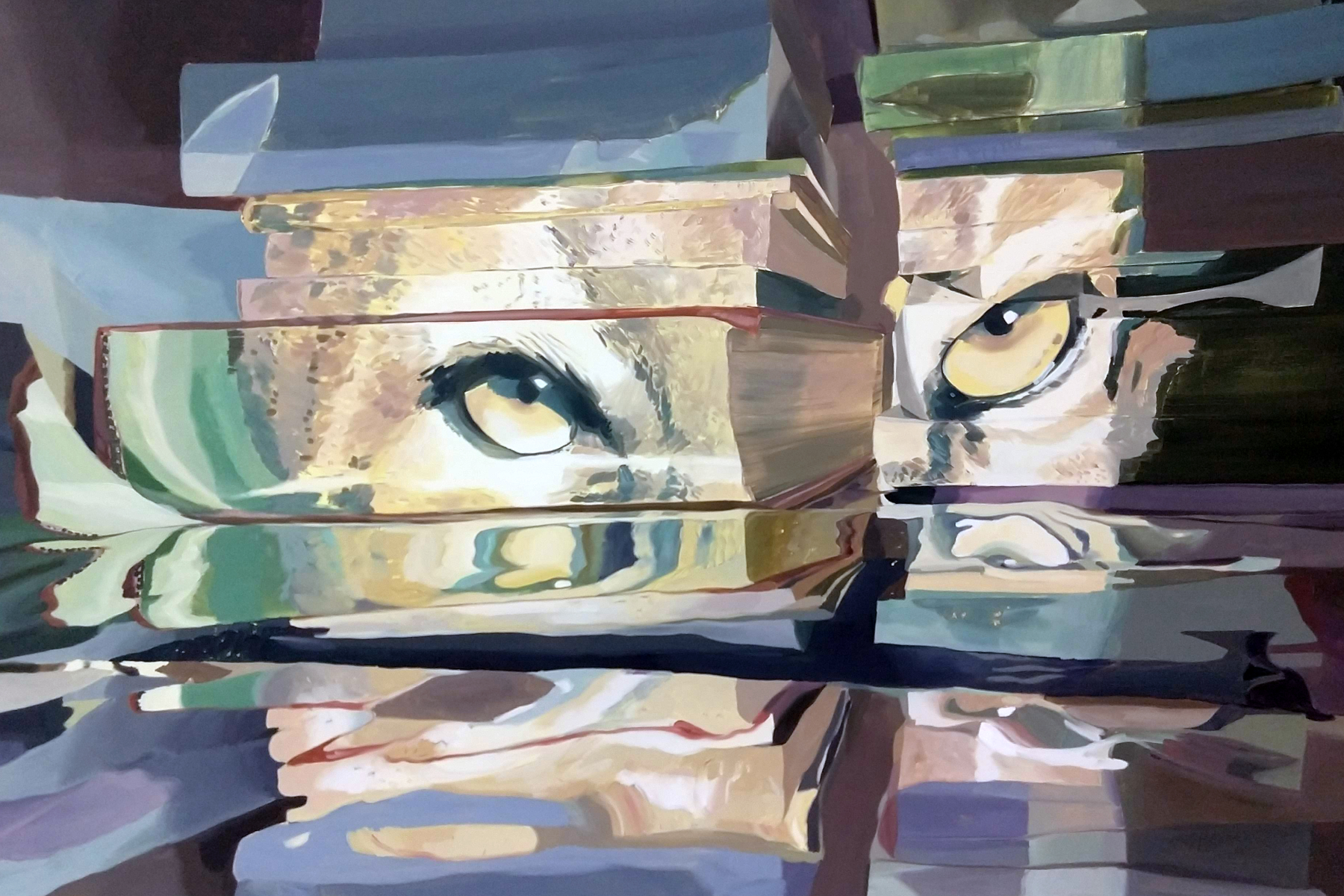
Descendants of Sire, solo exhibition by Brightwork Fellow Clarence Heyward, September 26 - October 9, 2020

2017 - 2020 Brightwork Fellows
Wu Xiaowei
Wu Xiaowei (b. 1996) is a Chinese-born American artist working in video and painting. She graduated from UNC Chapel Hill in 2019 with a B.S. in mathematics and a B.A. in studio art.
Her work examines the perception of reality as mediated by visual experiences, and questions alignments of the world with the visible world. She takes interest in darkness as an extinguishing impulse in representations, as well as an aesthetic to resist coding by popular entertainment and commercial art.
Time and room for poetry. Her video work shares the treatment of time with slow cinema and dilutes the image, which combined with sound and text evoke invisible spacetime, such as one revolving around visions of abstractions from her mathematical training, personal and collective memories, and experiences with her native language and acquired languages.
LAKESHIA REID
My work offers interpretations of #BlackGirlMagic - a phrase/movement that celebrates positive messages and images of black women, with a nod to the fantastical. In my most recent works, I use the duality of abstraction and representation to reimagine women of various demeanors as archetypes from Tarot cards. They are surrounded by colorful layers of ornamentation, texture and elements of nature. In this context, I explore their identities, and my own, while crossing a conceptual threshold.
AYLA GIZLICE
Ayla Gizlice makes work that advocates for the local environment in sustainable ways. She primarily works with found objects and gathers her materials from specific locations that speak to the environmental issues the work addresses. The role of labor is a key element in her practice; by collecting and displaying material with limited intervention the authorship of the work shifts. Rather than the environment acting as a cornucopia from which she plucks materials, she becomes a laborer or mediator for the material. Gizlice’s practice compliments the abstract, poetic gestures made by her sculptures with more pointed multi-media work that contextual and displays data, which together act as a quiet protest against environmental degradation.
CLARENCE HEYWARD
Clarence Heyward is a figurative painter working to create a visual narrative centering faces he feels are often dismissed. Introduced to art through community programming and mentorship, Clarence hopes to reflect that community through visual commentary on past and current events.
Annie Blazejack
Annie Blazejack works with oil paint, textile installation, performance, and video work, following ideas from one material to the next. She graduated from Brown University, and received her MFA from The School of the Museum of Fine Arts, Boston / Tufts University in 2013. While pursuing her graduate degree, Blazejack began a long-term collaboration with Brooklyn-based painter Geddes Levenson. Their artworks weave a feminist, environmentalist sci-fi narrative.
Jennifer Markowitz
Jennifer Markowitz is a textile artist whose current project, Fleshmap: My Embroidered, Bipolar Geographies consists of a large series of hand embroidered panels mapping years/countries/cities she lived in while battling bipolar disorder. Her work has been shown at VAE Raleigh, The Humanities Center and the Weems Art Gallery. She is a recipient of the 2018 Career Development Grant from United Arts.
Before turning to textiles, Jennifer spent 25 years directing environmental theatre in Chicago, New York, Los Angeles as well as in England, Scotland, Ireland and Israel. In England, where she received her Master’s Degree in Theatre Research/Practice at the University of Warwick, she formed a site-based theatre company called Trema (a German term referring to both stage-fright and the moment prior to a psychotic break). With Trema, she directed site-responsive productions throughout the Midlands of the UK.
Jennifer has taught Performance Theory, Acting, Directing, Theatre Studies, Site-Based theatre and Postdramatic Theatre in the UK at the universities of Warwick, Birmingham, Manchester, Portsmouth and Plymouth. She has also taught Practice as Research methodologies and Site-Based Performance to MA Students in Reykjavik, Iceland. In the US, she both taught acting, performance theatre and guest directed at DePaul University, Columbia College Chicago and University of Notre Dame.
Julia Caston
Julia Caston creates interactive experiences for people based on concepts of belonging, privilege, humor, compassion, and interpersonal communication. Her practice encompasses drawing, sculpture, and performance art.
Julia Caston is a queer cisgender white woman from Minneapolis, MN. She received her BA in Art History from Barnard College and her MFA from the University of North Carolina Greensboro. Julia has participated in residencies in Franconia Sculpture Park in Minnesota, the Kimmel Harding Nelson Center for the Arts in Nebraska City, Artspace in Raleigh, NC, and is a current Brightwork Fellow at Anchorlight in Raleigh, NC. She has shown her work locally, nationally, and abroad. Julia is the co-founder of the nonprofit Minneapolis Art Lending Library, an organization that lends original works of art to the public, free of charge.
André Leon Gray
Raleigh native André Leon Gray is a self-trained artist who works in a variety of media to examine the impact of history on present day power structures and social hierarchies. He transforms mundane objects and materials into powerful social commentaries to encourage conversations among his diverse audience.
Gray uses discarded materials, including crutches, police barrier tape and imagery found on the internet, to create a coded visual language. In his artistic practice, he loves to examine, dissect and arrange multiple sources of information into his work. He samples symbols of Western culture like a hip hop producer and remixes the content into a new narrative. Using a variety of disciplines, including painting, mixed media, assemblage, drawing and installation, he reassembles them in a manner that becomes more than the sum of its parts. Language is frequently applied to the surface as a point of entry, to examine how words are used as representations and declarations of power to define parameters in social hierarchies. Gray envisions art as a transformative tool to advance our understanding of each other, the world around us, and the cultural necessity to advance humanity in the right direction that benefits us all.
His recipe of historical and contemporary references, are continually stirred in his hearty pot of eye gumbo: a visual meal for the mind, thickened with a roux of black culture, marinated in social commentary and seasoned with consciousness.
Gray has exhibited work at Prizm Art Fair 2017, the Orlando Museum of Art, Duke Performances’ “Monk @100: A Century of Genius” in Durham, Nasher Museum of Art at Duke University, SCOPE Miami 2012, and the United Nations Headquarters in New York City. His work is in the permanent collection of the North Carolina Museum of Art.
Sally Van Gorder
Sally Van Gorder is an interdisciplinary artist whose practice investigates the intersections of identity, self-representation and social structures. Using a wide range of media and systems of collection, documentation and classification, Van Gorder creates work that addresses impermanence and
autobiography in domestic environments. Her process melds comprehensive subject matter research with experimental, iterative making to create work that simultaneously reveals and discovers. She leverages ambiguity and contradiction to expose the enigmatic in the human and divine. Her work resides in the realms of experimental documentary, time-based media, installation, printmaking and science photography.
Van Gorder received her BA in Studio Art from Meredith College and a Master of Art + Design in Animation and Interactive Media from North Carolina State University. She has exhibited work at the North Carolina Museum of Art, Southeastern Center for Contemporary Art, Contemporary Art Museum Raleigh, Duke University Museum of Art and The Ukrainian Institute of Modern Art. Her films have been screened at the Ann Arbor Film Festival, DOXA Vancouver, 1 Reel Film Festival Seattle and the
Yamagata International Documentary Film Festival.
Cliff Elliott
Cliff Elliott makes work that expresses the impact of Western commercialized society on the construct of identity. After receiving an MFA in Illustration from the Savannah College of Art and Design in 2007 Elliott embarked on an intense and mostly private home studio practice. Working from an expansive visual library primarily compiled through years of dedicated sketchbook keeping, Elliot toggles between digital production and hand-embellishment to create vibrant mixed media collages. Blending both appropriated and original imagery Elliott works intuitively, layering images and marks until the right composition emerges. Using this method Elliott’s practice allows him to explore both the internal and external projections of identity, and as a result each piece reflects an aspect of the self otherwise unseen.
William Paul Thomas
William Paul Thomas utilizes his immediate social network and life experiences to produce paintings, prints, and videos that offer complex and enigmatic representations of people of color. Thomas paints representations of the disembodied heads of people in his social circle, and sometimes scrawls text directly over their likenesses. That text is often tinged with dry humor, at times politically incorrect, and is regularly derived from the spoken vernacular of the communities Thomas has been reared by. His overarching goal is to share with diverse audiences what he sees as worthwhile subject matter. That might include religious symbolism or popular slang. Painting is his way of capsulizing this broad, ongoing exploration of the human condition.
Thomas chooses specific models as a way of recognizing their significance in his life’s path. He relishes being able to honor everyday people through making images. As society regularly celebrates women and men of prominence in mass media, Thomas takes advantage of the opportunity to highlight the people that impact him on a more direct level than any untouchable celebrity or distant historical figure could. Thomas integrates text and other symbols into the portrait work to narrow the subject matter to a certain degree and complicate the viewer’s understanding of the portrait subject’s identity. The work begins as an intimate acknowledgement of an individual and is subsequently transformed into a set of symbols poised for the viewer’s investigation.
In 2016, Thomas was the inaugural Artist in Residence at the Power Plant Gallery located on the American Tobacco Campus in Durham, NC and was the recipient of an Ella Fountain Pratt Emerging Artist Grant. Thomas is an alumnus of the Master of Fine Arts program in Studio Art at the University of North Carolina at Chapel Hill. He frequently collaborates with NC-based non-profit Hidden Voices, an organization that brings forward stories of marginalized populations through the arts. Follow updates from the artist via his social media handle, @willart4food.












